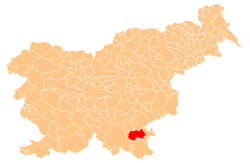Starološki Grič
Starološki Grič (pronounced [staɾɔˈloːʃki ˈɡɾiːtʃ]; German: Altlagbüchel,[1] Gottscheerish: Autlogpichl or Lockpiechl[2]) is a remote abandoned settlement in the Municipality of Semič in southern Slovenia. The area is part of the traditional region of Lower Carniola and is now included in the Southeast Slovenia Statistical Region.[3] Its territory is now part of the village of Planina.[4]
Starološki Grič | |
|---|---|
 Starološki Grič Location in Slovenia | |
| Coordinates: 45°37′5.52″N 15°3′38.88″E | |
| Country | |
| Traditional region | Lower Carniola |
| Statistical region | Southeast Slovenia |
| Municipality | Semič |
| Population (2002) | |
| • Total | 0 |
Name
The name of the village is also recorded as Lackh Püchel and Logbichl in old land registries, and was known as Autlogpichl, Lockpiechl,[2] or Logpichl[5]:70 in the Gottschee German dialect. The designation Staro-/Alt- 'old' distinguished the settlement from the nearby younger settlement of Novološki Grič (German: Neu-Lagbüchel).[5]:63[6] Both the Slovene name and German names literally mean '(old) hill near a marshy meadow'. Slovene place names containing the word grič 'small hill' are relatively common and may historically refer to elevations rising over 100 meters.[7]
History
The land registries of 1574 and 1770 indicate that Starološki Grič consisted of one hide and four houses,[5]:63 with a population of six landowners and 12 to 15 residents altogether.[2] In 1817 the village still had four houses and its population was 26.[8] The village was abandoned by the end of the 19th century[4] due to emigration to the United States.[9] It was sold off to the Auersperg noble family in the 1890s to provide housing for their forestry workers. The abandoned village burned before the First World War.[2]
Cultural heritage
The entire former village site is registered as cultural heritage, including ruins of buildings, a well, outlines of overgrown fields, and the remains of a linden-tree avenue.[4] The ruins of the 16th-century village Chapel of Saint Ulrich are also registered as cultural heritage. This was a single-nave building with a narrow single-bay octagonal chancel walled on five sides. The remnants of a carved travertine arch and a narrow window in the chancel show that the chapel was built in the Gothic style.[10]
References
- Ferenc, Mitja. 2007. Nekdanji nemški jezikovni otok na kočevskem. Kočevje: Pokrajinski muzej, p. 4.
- Petschauer, Erich. 1980. "Die Gottscheer Siedlungen – Ortsnamenverzeichnis." In Das Jahrhundertbuch der Gottscheer (pp. 181–197). Klagenfurt: Leustik.
- Semič municipal site
- Slovenian Ministry of Culture register of national heritage reference number ešd 19507
- Simonič, Ivan. 1935. "Kočevarji v luči krajevnih in ledinskih imen." Glasnik Muzejskega društva za Slovenijo 16: 61–81 and 106–123.
- Heberle, Gregor. 2008. Političnogeografska analiza nekdanjega kočevarskega jezikovnega otoka. Ljubljana: University of Ljubljana, Faculty of Arts, Department of Geography, p. 64. (in Slovene)
- Snoj, Marko. 2009. Etimološki slovar slovenskih zemljepisnih imen. Ljubljana: Modrijan and Založba ZRC, pp. 153–154.
- Haupt-Ausweis über die Eintheilung des Laibacher Gouvernementsgebiethes. 1817. Ljubljana: Eger.
- von Engel, Alexander. 1907. Oesterreichs Holz-Industrie und Holzhandel. Vienna: Frick, p. 41.
- Slovenian Ministry of Culture register of national heritage reference number ešd 18401
